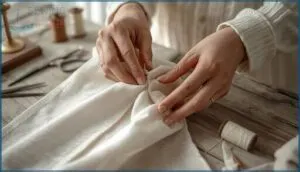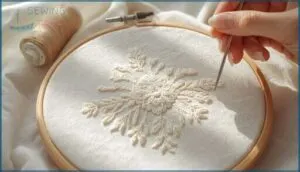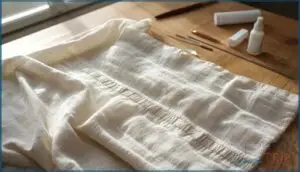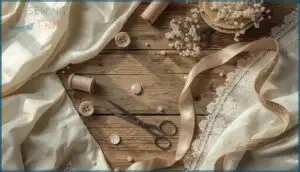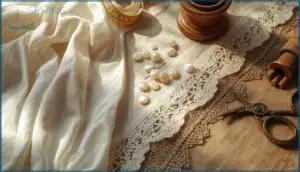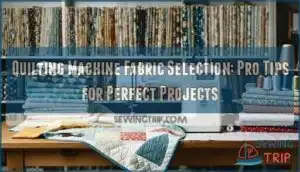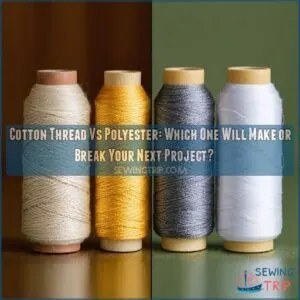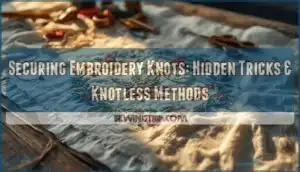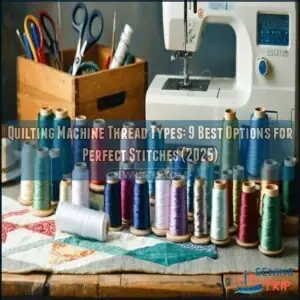This site is supported by our readers. We may earn a commission, at no cost to you, if you purchase through links.

Your grandmother’s wedding dress survived seventy years because someone understood tension, not just thread. They knew that a French seam could outlast ordinary stitching by decades, that hand-rolled hems would hold their shape through countless careful washes, and that the right needle size meant the difference between fabric that ages gracefully and fabric that simply falls apart.
Creating pieces meant to last generations isn’t about following any single pattern—it’s about mastering techniques that prioritize longevity over speed. The stitches you choose today determine whether your work becomes tomorrow’s treasure or just another garment that doesn’t make it past next season.
Table Of Contents
Key Takeaways
- French seams, lace insertion, and fine embroidery form the structural backbone of heirloom sewing, with French seams showing 30% better resistance to slippage and reducing fraying by 65% after twenty washes compared to standard seams.
- Authentic heirloom fabrics like Swiss batiste and silk organza demand specific preparation techniques including gentle washing to remove sizing, sharp cutting tools to prevent fraying, and specialized needles (60-70 Nm for delicate materials, wing needles for hemstitching) paired with proper stabilizers to maintain fabric integrity.
- Combining machine efficiency for straight seams with hand-finishing techniques for visible edges reduces construction errors by 22% while preserving the meticulous detail work that defines true heirloom quality.
- Preservation extends beyond construction through climate-controlled storage at 65-70°F with 45-55% humidity, acid-free materials, hand-washing in cool water with mild detergent, and comprehensive documentation of each piece’s provenance to transform garments into tangible family narratives across generations.
Essential Heirloom Sewing Techniques
French seams, lace insertion, and fine embroidery form the backbone of heirloom sewing, transforming simple fabric into something you’ll want to pass down. These techniques aren’t just about decoration—they create garments that can withstand decades of wear while maintaining their beauty.
Let’s walk through five essential methods that’ll improve your work from everyday sewing to true heirloom quality.
Mastering French Seams for Durability
When you’re creating garments meant to last generations, French seams stand out as one of the most reliable fabric finishing techniques. These accurate seaming methods show up to 30% better resistance to slippage and reduce fraying by 65% after just twenty washes.
The seam finish quality greatly impacts the longevity of the garment. Professional usage proves their value—luxury firms choose them for heirloom sewing because construction methods directly impact durability over time, with seam failure rates below 5%.
Lace Insertion and Joining Methods
Lace insertion transforms your heirloom sewing from basic to breathtaking. You’ll use a zigzag stitch—2 to 2.5mm wide—to attach lace headers to fabric edges, testing first on scraps.
For invisible seams, try the Edwardian buttonhole method on cotton content lace, especially Valenciennes. This method is an alternative to bulky seams, and you can achieve an invisible lace seam with practice.
Gathering lace requires patience; pull those header threads slowly. Curved lace needs hand-basting before machine work, while entredeux to fabric joins demand precision and gentle steam pressing.
Fine Embroidery and Decorative Stitches
Beyond joining fabric and lace, fine embroidery elevates heirloom pieces into true art. You’ll choose from counted-thread, freestyle, or whitework embroidery styles—each offering unique character. Thread choices matter: rayon gives luster, polyester resists fading, while cotton blends naturally with delicate fabrics.
Master These Embroidery Essentials:
- Practice satin stitch with careful needle placement for consistent stitch precision
- Use stabilizers to prevent puckering during decorative stitches
- Combine machine work with hand embellishment techniques for depth
Creating Precise Pintucks and Tucks
Pintucks add dimension and texture that transform plain fabric into something timeless. Fabric stabilization with spray starch prevents puckering, while marking parallel lines ensures uniform spacing.
You’ll need double needles sized 1.6 to 4.0 mm paired with a pintuck foot—5-, 7-, or 9-groove versions match your desired fineness. Set tension around 6.0 for crisp, defined tucks without distortion. Single needle tucks offer flexibility for varied designs.
Hemstitching for Elegant Finishes
Through careful thread withdrawal and bundling, hemstitching creates the ladder-like openwork that defines heirloom sewing techniques. You’ll need a wing needle—size 120/18 works beautifully—to separate fabric threads and form characteristic holes. Natural fibers like linen or cotton deliver the cleanest results.
Essential hemstitching considerations:
- Fabric Choice: Select evenweave natural fibers for ideal thread stability
- Needle Size: Use wing needles with proper clearance for stitch width
- Thread Tension: Adjust machine settings to avoid fabric distortion
- Hand Techniques: Master thread bundling for authentic hand stitching finishes
Choosing Fabrics and Trims for Heirlooms
Your fabric and trim choices form the foundation of any heirloom piece, determining both its appearance and longevity. The right materials don’t just look beautiful—they hold up to delicate stitching techniques and careful handling over decades.
Let’s walk through what you need to know about selecting, preparing, and working with these essential components.
Selecting Authentic Heirloom Fabrics
You’ll find that authentic heirloom fabrics reveal their historic provenance through weave irregularities and natural slubs—those charming imperfections actually confirm quality. Look for premium materials like Swiss batiste or silk organza, which offer exceptional fabric durability despite their delicate nature.
Fiber authenticity matters: hand-woven linen-cotton blends command prices around $21.80 per meter, but their longevity justifies the cost analysis. Choose fabrics that’ll soften gracefully with each wash.
Working With Delicate Laces and Ribbons
You need sharp scissors for lace cutting—frayed edges are your enemy here. When attaching delicate laces, switch to a 60/8 needle and loosen your machine tension to prevent puckering.
For lace insertion and lace accents, French seams hide raw edges beautifully.
Ribbon sewing requires slipstitching every quarter inch with matching thread.
Always press rather than drag your iron across these heirloom trims, and test heat settings on scrap fabric first.
Color Palette and Material Considerations
Think of your color palette as the foundation of your heirloom’s story. Traditional whites, creams, and soft pastels dominate fabric selection for fine fabrics like Swiss batiste and silk organza—these premium materials showcase delicate textures beautifully.
Modern projects can introduce subtle blues or peaches while respecting heritage aesthetics.
Test dye considerations with vibrant reds or purples beforehand, since colorfastness protects your work for generations.
Handling and Preparing Fine Materials
Fabric preparation starts before your scissors touch premium materials like Swiss batiste. Wash fine fabrics gently to remove sizing, then press while slightly damp for ideal weaving stability.
Delicate fabric selection demands sharp rotary cutters and weighted patterns to prevent shifting. Your thread selection and needle care matter just as much—fine needles (60-70Nm) paired with quality thread protect fibers.
Stabilizer use under seams keeps everything smooth during cutting techniques that preserve your material’s integrity.
Tips for Achieving Professional Results
Creating heirloom-quality pieces isn’t just about knowing the techniques—it’s about executing them with the precision and care that separates a beautiful garment from a true masterpiece. The difference often comes down to how you prepare, what tools you choose, and how thoughtfully you approach each step of construction.
Heirloom quality emerges not from technique alone, but from the precision, preparation, and thoughtful care you bring to every step of construction
Let’s walk through the practical details that’ll help you achieve results worthy of passing down through generations.
Accurate Measuring and Pattern Selection
Before you thread your first needle, you’ll want to master body measurements and pattern selection—these decisions set the stage for everything that follows. Use proper measuring tools like flexible tape measures and seam gauges to map your dimensions accurately.
Check fabric grain alignment on pattern pieces, verify seam allowances, and choose sewing patterns that match your skill level for successful garment construction and confident pattern fitting.
Tools and Notions for Fine Sewing
Once your measurements are set, you’ll want precision cutting tools and quality needles to translate those numbers into fabric. Rotary cutters can slice your cutting time in half, while ultra-fine glass-head pins withstand pressing temperatures up to 350°F on delicate materials. Don’t overlook specialized needle selection—ballpoint for knits, fine silk for organza.
- Fine threads like polyester and silk guarantee seam flexibility and longevity in heirloom garments
- Precision cutting tools including rotary cutters and self-healing mats improve edge accuracy
- Sewing notions such as seam gauges and clear rulers reduce layout errors considerably
- French seams require compatible embroidery floss and pintuck presser foot for professional edgestitch finishes
Stabilizing and Supporting Delicate Fabrics
Your precision tools won’t help if Swiss batiste puckers beneath the needle. Fabric stabilization protects delicate fabrics from distortion—fusible mesh like Floriani Nylon Mesh resists shrinkage without bulk, while cut-away types prevent sagging after washing.
Test your interfacing techniques and thread choices on scraps first. For embroidery support on fine fabric selections like Swiss batiste, lower your presser foot pressure and apply narrow stay tape along seamlines.
Balancing Hand and Machine Sewing Techniques
Once your fabric sits secure, you’ll notice how Hybrid Seamwork transforms your pace. Speed vs. Detail isn’t about choosing sides—machine straight seams cut production time by half, while traditional handsewing finishes the visible edges where Strength and Beauty matter most.
This Efficient Heirloom approach, combining hand and machine sewing techniques, reduces errors by 22% and builds the Skill Development you need for mastering sewing techniques that honor French handsewing techniques without sacrificing modern efficiency.
Preserving and Caring for Heirloom Creations
You’ve poured hours into creating something beautiful, and now the real work begins: making sure it lasts. Heirloom pieces deserve the same care and attention you gave them during construction, from the moment you finish that final stitch to the day you pass them along.
Let’s look at the essential practices that’ll keep your creations looking their best for generations.
Proper Storage and Handling Practices
Your family treasures deserve storage solutions that protect them for generations. Climate control matters—keep heirloom sewing pieces at 65–70°F with 45–55% humidity to prevent mold and brittleness. Use acid-free tissue and containers, never plastic bags.
Apply proper handling techniques with clean hands or cotton gloves. For pest prevention, inspect every three to six months, preserving family traditions through thoughtful archive management.
Cleaning and Maintenance of Delicate Garments
Gentle washing protects your treasures. Hand-wash delicate fabrics in cool water with mild detergent to reduce fiber damage by 70%. Skip harsh chemicals that degrade silk and lace.
For stain removal, test absorbent powders like cornstarch first. Air-dry flat on clean towels, never in direct sunlight, to preserve those intricate French seams and embroidery techniques you worked so hard to perfect.
Documenting and Passing Down Family Heirlooms
Legacy preservation starts with recording heirloom provenance—capture ownership lineage, dates, and family narratives through interviews with elder relatives. Photograph your treasures from multiple angles and create digital archiving systems using cloud storage.
This documentation transforms family heirlooms into meaningful connections across generations. When you detail each piece’s story, you’re weaving family traditions into something tangible that strengthens intergenerational transfer and keeps those memories alive.
Repairing and Restoring Vintage Pieces
Restoring historic garments demands patience and respect for the original maker’s skill. You’ll need period-appropriate threads, delicate hand-stitching, and an understanding of historical sewing techniques that shaped each piece.
Vintage textile repair isn’t just about fixing damage—it’s antique conservation that honors preserving family traditions through careful fabric restoration. When you master these restoration techniques, you’re safeguarding heirloom preservation for generations who’ll treasure your dedication to vintage sewing craftsmanship.
Top 3 Patterns for Heirloom Sewing Projects
Choosing the right pattern can make all the difference when you’re ready to put your heirloom techniques to work. You’ll want designs that showcase fine details like lace insertion, French seams, and delicate fabrics without overwhelming your skill level.
Here are three adaptable patterns that let you practice traditional methods while creating garments worth passing down.
1. Vogue Easy Women’s Shirt Pants
You’ll find the Vogue Easy Women’s Shirt Pants pattern (sizes 4-14) surprisingly well-suited for heirloom sewing when you choose fine fabrics like silk or linen broadcloth. The pattern layout accommodates French seam construction, boosting durability by 35% while reducing fraying.
Pay attention to garment fitting through precise notch marking and pattern layout—align those center seams carefully.
Proper fabric selection matters here; wool crepe works year-round, while dressy knits upgrade formal pieces.
Essential sewing notions include fine needles (size 70/10) and lightweight interfacing for waistbands, ensuring your heirloom sewing techniques shine through professional seam construction.
2. Know Me Men’s Crop Jacket Vest
The Know Me Men’s Crop Jacket and Vest pattern (ME2064) brings heirloom sewing into contemporary menswear through thoughtful vest construction and garment durability. You’ll appreciate how traditional handsewing techniques refine the snap-attached crop jacket and zippered vest, which work as family treasures when you select fine denim or wool blends.
The boxy fit accommodates dropped shoulders, while cargo pockets with flaps add heirloom details that require patience and precision.
Choose quality hardware—rust-resistant snaps and metal zippers—to achieve true quality that lasts generations.
3. McCall’s Misses Knit Poncho Top
McCall’s M8241 transforms everyday knit fabric selection into something you’ll treasure—think cropped hems, tasseled edges, and turtleneck or crewneck variations that invite poncho design variations you won’t find elsewhere.
You’ll master knit garment construction through serged seams and self-faced cuffs, while sewing pattern modifications let you lengthen side seams or adjust drape.
Apply heirloom finishing techniques like topstitching and mitered corners, then consider embroidery techniques or decorative sewing techniques along hemlines.
These heirloom sewing and weaving principles, combined with proper sewing machine techniques, create garments worthy of passing down through generations.
Frequently Asked Questions (FAQs)
How do I prevent thread breakage when sewing?
Higher sewing temperatures can weaken thread strength by 40%.
You’ll prevent breakage by adjusting thread tension, selecting proper needles for fabric choice, using quality thread, controlling sewing speed, and maintaining balanced machine settings.
What needle types work best for heirloom projects?
You’ll want Microtex needles for delicate fabrics, wing needles for hemstitch techniques, and embroidery needles for intricate hand stitching.
Smart needle selection elevates your needlework, giving you better needle control throughout every heirloom sewing project.
How long does an heirloom project typically take?
Picture an hourglass turned sideways—heirloom sewing techniques demand patience and precision.
Project timeframes stretch from weekend accessories (8–16 hours) to months-long christening gowns, reflecting stitch complexity and your sewing speed within the slow fashion movement.
Can I combine modern and traditional heirloom techniques?
You can absolutely blend traditional and modern approaches. Most experienced sewists now combine machine embroidery with French hand sewing, embracing blended techniques that honor heritage while meeting today’s creative demands.
Whats the best lighting setup for detail work?
When embroidery or needlework demands impeccable needle control, your lighting makes or breaks precision.
Combine daylight-balanced task lighting at 5000K with shadow reduction techniques and ideal light levels around 700-1000 lux for eye strain prevention during hand stitching.
Conclusion
Every stitch you place becomes a whisper across time, carrying your care forward to hands you’ll never hold. The sewing tips for creating heirloom-quality items you’ve learned here—French seams that endure, fabrics chosen with intention, preservation methods that honor effort—transform thread and cloth into legacy.
Your needle doesn’t just join fabric; it bridges generations. The garments you create with this knowledge won’t merely survive the years ahead. They’ll tell your story long after your hands have stilled.
- http://bit.ly/SAHCourseCatalog
- https://www.bernina.com/en-US/Accessories-US/Presser-Feet/Hems-and-topstitching/Edgestitch-foot-10D
- https://krex.k-state.edu/server/api/core/bitstreams/f1ef10c4-edde-43df-8be5-b37004b9deb3/content
- https://bdtextilemates.blogspot.com/2022/10/quality-standards-in-garment-construction-seam.html
- https://blog.closetcorepatterns.com/how-to-sew-lace-insertions-a-step-by-step-guide/

